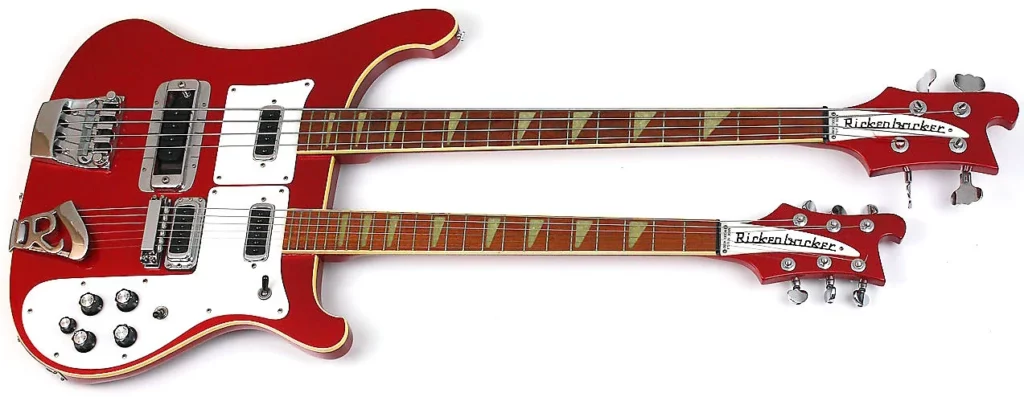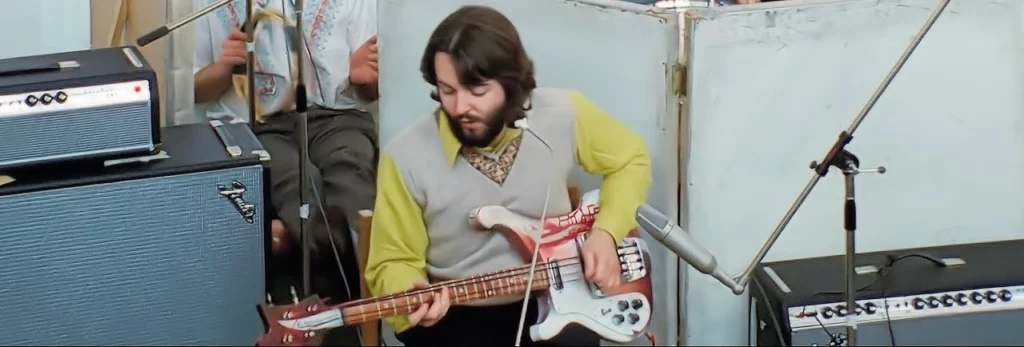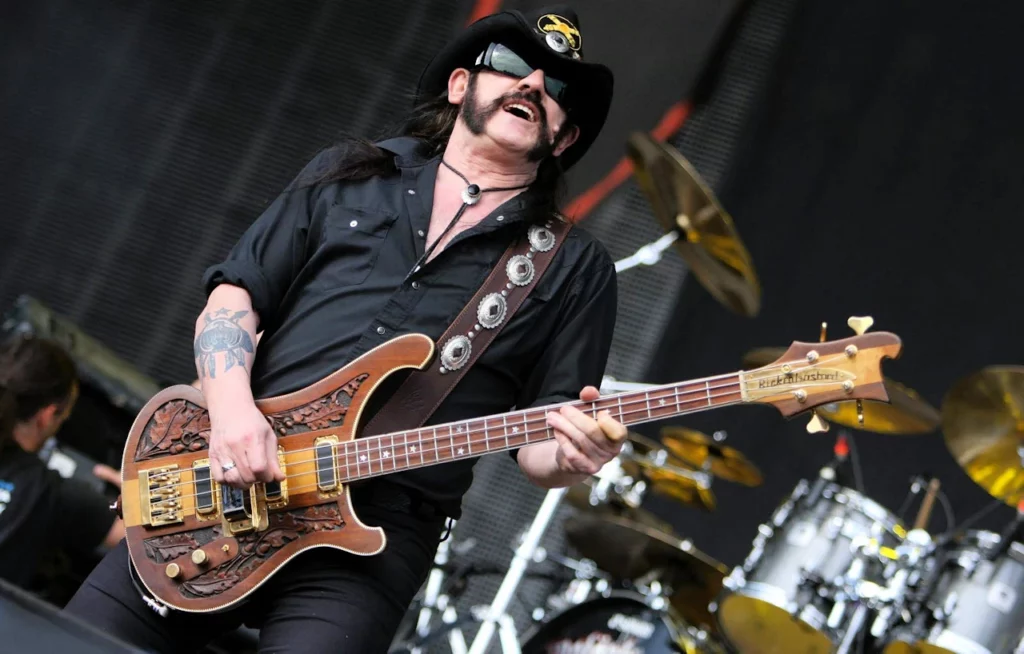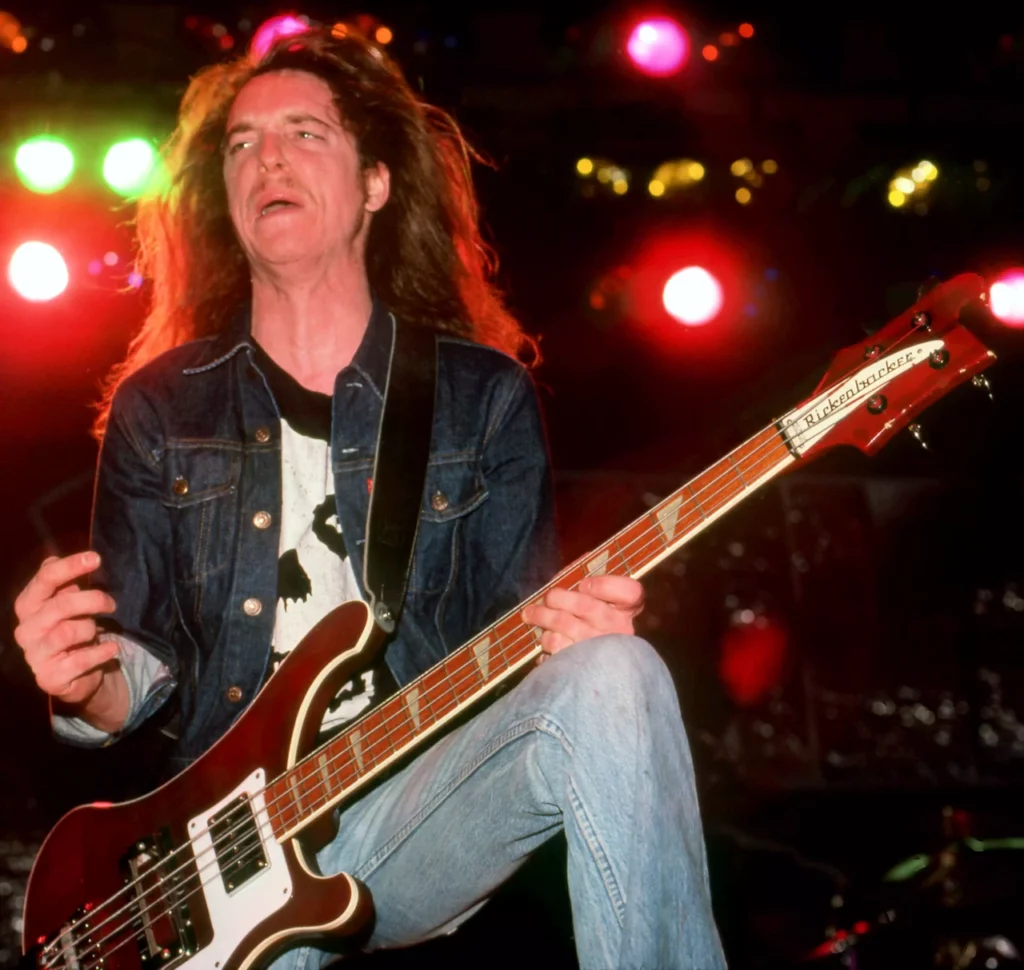Rickenbacker basses, initially known as the “Electro String Instrument Corporation”, was founded in 1931 by Adolph Rickenbacker and George Beauchamp in Los Angeles, California. The company is also known for producing the “Frying Pan”, which is considered to be the first mass-produced full-body electric guitar.

Rickenbacker basses is a brand with a long history and many curiosities related to its name. Here are some of the most interesting ones:
- Original Name: The company was originally called “Electro String Instrument Corporation”. “Rickenbacker” was adopted as the brand name in homage to Adolph Rickenbacker, one of the founders.
- Late 50s: Rickenbacker introduces the 4000 model, the first bass in its line. It’s a solid-body bass with a unique design, unlike any other bass on the market at the time. The 4000 has only one pickup and no string markers on the fretboard.
- Use by the Beatles: Although Paul McCartney is famous for his Höfner “Violin Bass”, he also used a Rickenbacker 4001S.
- Distinctive Design: One of the standout features is the double truss rod that offers an added strength and stability to the neck.
- Rejection of endorsements: Unlike many other musical instrument companies, Rickenbacker has a policy of not providing endorsements or free instruments to musicians. Despite this, many artists have chosen to use their products because of the distinctive quality and sound.
- Manufacturing in the USA: While many bass manufacturers have moved some of their production to other nations to reduce costs, Rickenbacker has kept the main production in the United States.
- Restrictions on online sales: For many years, Rickenbacker had a very restrictive policy regarding selling their products online, preferring that customers visit physical stores to try out the tools before purchasing.
In terms of construction, Rickenbackers basses are known for their use of high-quality woods such as maple and rosewood. The double truss rod system ensures stability and strength to the neck. The pickups, often customized for Rickenbacker, contribute to the distinctive, rich sound for which the brand is known. The “neck-through” construction (the neck and body are a single piece of wood) in many models offers greater sustain and tonal response. Here is the description of the most famous ones:
Rickenbacker 4001:

The Rickenbacker 4001 is one of the most iconic basses produced by Rickenbacker and has a special place in the history of rock and electric bass. Here are some of the features and technical specifications of the Rickenbacker 4001:
- Body: Typically made of maple, with a distinctive “double shoulder” design. The shape is recognizable and different from the most common designs such as Fender Precision or Jazz Bass.
- Neck: “Neck-through” construction, which means that the neck and central body are made of a single piece of wood, offering greater sustain and stability. The fingerboard is usually made of rosewood.
- Frets: 20 frets, with characteristic triangle string markers.
- Pickups: The 4001 comes with two pickups, a single-coil at the bridge and a humbucker at the neck. This combination offers a wide range of tones, from bright and edgy to warm and deep.
- Bridge: Equipped with a bridge that allows bassists to choose between a “rick-o-sound” (stereo) or standard intonation.
- Tuners: Traditional open-key tuners.
- Controls: Two volume controls, two tone controls, and a three-way pickup selector.
- Truss Rod: Double truss rod for added stability and strength of the neck.
- Finish: The Rickenbacker 4001 comes in a variety of finishes, but some of the most popular are Fireglo (gradient red), Jetglo (black), and Mapleglo (natural).
- Rick-O-Sound: This is a unique feature of many Rickenbacker models, including the 4001. It is a stereo output that allows musicians to send the signal from each pickup to two separate amplifiers or to separate channels of a mixer or recording device.
The Rickenbacker 4001 is known for its distinctive sound, which can range from deep, round tones to bright, edgy tones, depending on how it’s set up. Musicians such as Chris Squire of Yes and Geddy Lee of Rush helped popularize the “Rickenbacker sound” in their respective genres.
Rickenbacker 4003:

The Rickenbacker 4003 is the direct successor of the famous 4001 and continued Rickenbacker’s tradition of producing high-quality, high-quality basses. Here are the main features and technical specifications of the Rickenbacker 4003:
- Body: Usually made of maple, with Rickenbacker’s classic “double shoulder” design.
- Neck: “Neck-through” construction, where the neck and central body are made of a single piece of wood, offering greater sustain and stability. The fretboard is usually made of rosewood, but some special models may have fretboards made of other materials.
- Frets: 20 frets, with the classic triangle string markers set in.
- Pickups: A single-coil at the bridge and a humbucker at the neck. The 4003 model received some improvements in pickups over the 4001, offering greater output and clarity.
- Bridge: The 4003 is equipped with a bridge with a dual option for “rick-o-sound” (stereo) and standard pitch.
- Tuners: High-quality open-key tuners.
- Controls: Two volume controls, two tone controls, and a three-way pickup selector.
- Truss Rod: Double truss rod to ensure greater stability and strength of the neck.
- Finishes: Available in a variety of finishes, including Fireglo, Jetglo, Mapleglo.
- Push/Pull Pot: One of the main differences between the 4003 and its predecessor 4001 is the addition of a push/pull potentiometer on top of the pickup tone control at the bridge. This allows players to add or remove a certain amount of mid-to-high frequencies, offering greater tonal versatility.
- Rick-O-Sound: Like the 4001, the 4003 has the Rick-O-Sound stereo output, which allows you to send the pick-up signal to two separate amplifiers or to separate channels of a mixer or recording device.
The Rickenbacker 4003 has retained many of the beloved features of the 4001, but with upgrades and improvements that make it even more versatile and adaptable to a variety of musical styles.
Rickenbacker 4004:

The Rickenbacker 4004 is another notable model in the line of tools produced by Rickenbacker. It stands out with some unique specifications and designs compared to the more famous 4001 and 4003. Here are the main features and technical specifications of the Rickenbacker 4004:
- Body: Usually made of maple, with a slightly different and more modern shape than Rickenbacker’s classic “double shoulder” design, and may feature rounded edges.
- Neck: The 4004 features a “neck-through” construction, where the neck and central body are made of a single piece of wood, offering greater sustain and stability. The fretboard is typically made of rosewood.
- Frets: 20 frets, with traditional string markers.
- Pick-ups: Depending on the model variants, the 4004 can be equipped with two humbuckers or a combination of single-coils and humbuckers. These pick-ups offer a wide tonal range, from deep, warm sounds to bright, clear tones.
- Bridge: Traditional Rickenbacker design with adjustable spacing for each string.
- Tuning Machines: High-quality tuners for intonation stability.
- Controls: Two volume controls and two tone controls, with a three-way pickup selector.
- Truss Rod: Double truss rod, typical of Rickenbacker constructions, to ensure greater stability and strength of the neck.
- Finish: Like other models from Rickenbacker, the 4004 is available in a variety of finishes, including classics like Fireglo and Jetglo, as well as other specialty finishes.
- Design: The 4004, with its slightly different design, offers an alternative for those bassists who are looking for the sound and quality of Rickenbacker but want something aesthetically different from the more traditional models.
Overall, the Rickenbacker 4004 maintains the brand’s heritage of quality and sound, but with a slightly different aesthetic and specs that make it unique in its lineup.
Rickenbacker 4005:

The Rickenbacker 4005 is a unique bass in the bass line produced by Rickenbacker, mainly because it is one of the few semi-acoustic models they have produced. This model was introduced in the 60s and produced until the 80s. Here are the main features and technical specifications of the Rickenbacker 4005:
- Body: Semi-acoustic with “f”-holes. The body is usually made of maple and has a resonance chamber, unlike solid-body models such as the 4001 and 4003.
- Neck: “Neck-through” construction, where the neck and central body are made of a single piece of wood, offering greater sustain and stability. The fretboard is usually made of rosewood.
- Frets: 21 frets, with traditional string markers.
- Pick-up: Equipped with two single-coil Toaster pickups. These pickups deliver a bright, clearly defined sound, typical of early Rickenbacker models.
- Bridge: Traditional Rickenbacker design with adjustable spacing for each string.
- Tuning Machines: High-quality tuners for intonation stability.
- Controls: Two volume controls and two tone controls, with a three-way pickup selector.
- Truss Rod: Double truss rod, typical of Rickenbacker constructions, to ensure greater stability and strength of the neck.
- Finish: The 4005 was available in various finishes, including classics such as Fireglo, Mapleglo, and Jetglo.
- Design: With its semi-acoustic design, the 4005 stands out in the production line. In addition to its looks, the semi-acoustic design also offers a slightly different tone, with more resonance and acoustic feel.
The Rickenbacker 4005 has become a collector’s item due to its limited production and unique design. It offers a combination of vintage aesthetics, high-quality construction, and the distinctive Rickenbacker sound.
Rickenbacker 4008:

The Rickenbacker 4008 is a special model in the product catalog, thanks to its 8-string configuration. This bass is quite rare and stands out for its unique sound and aesthetics. Here are the main features and technical specifications of the Rickenbacker 4008:
- Body: Usually made from maple, retaining Rickenbacker’s traditional “double shoulder” design.
- Neck: “Neck-through” construction, where the neck and central body are made of a single piece of wood, offering greater sustain and stability. The fretboard is usually made of rosewood.
- Frets: 20 frets, with classic triangle string markers from Rickenbacker.
- Pick-ups: Two single-coil pickups, deliver a bright, clearly defined sound.
- Bridge: Traditional Rickenbacker design, adapted to accommodate string augmentation, with adjustable spacing for each string.
- Tuning Machines: High-quality tuners for intonation stability, adapted for string augmentation.
- Controls: Two volume controls and two tone controls, with a three-way pickup selector.
- Truss Rod: Double truss rod, typical of Rickenbacker constructions, to ensure greater stability and strength of the neck.
- Finish: Like other Rickenbacker models, the 4008 came in a variety of finishes, including classics like the Fireglo and Jetglo.
- Strings: The special feature of the 4008 is its 8-string configuration. Like a standard 4-string bass, but with additional octave strings for each main string, similar to the setup of a 12-string guitar.
Rickenbacker 4080:

The Rickenbacker 4080 is a special instrument in the world of basses and guitars. It is a “double neck” model that combines a bass and a guitar in one instrument. Here are the main features and technical specifications of the Rickenbacker 4080:
- Body: The 4080 has two necks on separate bodies combined into one instrument. Usually, the top neck is a bass guitar (similar to the 4001 or 4003) and the bottom neck is a 6-string guitar (similar to the 330 or 360 model).
- Necks: Both necks have a “neck-through” construction, where the neck and center body are made of a single piece of wood, offering added sustain and stability. Fretboards are usually made of rosewood.
- Frets: The bass has 20 frets, while the guitar has 24 frets. Both feature Rickenbacker’s triangle string markers.
- Pickups: The bass is generally equipped with two pickups, while the guitar has two hi-gain pickups.
- Bridges: Both necks have the traditional Rickenbacker bridge, each adapted to the strings and size of the specific instrument.
- Tuners: High-quality tuners for intonation stability on both necks.
- Controls: Each of the two instruments has its own separate controls, which include volume controls, tone controls, and pickup selectors.
- Truss Rod: Both necks are equipped with the double truss rod, typical of Rickenbacker constructions, to ensure greater stability and strength.
- Finish: Like other models, the 4080 came in a variety of finishes, including classics like Fireglo, Jetglo, and Mapleglo.
- Use: Thanks to its configuration, the Rickenbacker 4080 allows players to quickly switch between bass and guitar during a performance, making it ideal for situations where a quick transition between instruments is required.
The Rickenbacker 4080 is a fairly rare instrument and often sought after by collectors and fans of the brand. With its unique combination of guitar and bass in one instrument, it represents an interesting and unique part of Rickenbacker’s history.
The most famous musicians who have used Rickenbacker basses:
Paul McCartney (The Beatles)

Although best known for his Höfner Violin Bass, McCartney used a Rickenbacker 4001S on several occasions during his career with the Beatles.
Chris Squire (Yes):

Known for his virtuoso style based on the bi-amping technique, with the bass sounds of the instrument being sent to a bass amp and the high sounds to a guitar amp, Squire used a Rickenbacker 4001 as his main instrument, contributing to Yes’ prog rock sound.
Geddy Lee (Rush):

Although often associated with Fender basses, Geddy Lee has used a Rickenbacker 4080 double neck on several classic Rush tracks.
Lemmy Kilmister (Motörhead):

Lemmy is known for his powerful, distorted bass sound, achieved in part thanks to his custom Rickenbacker 4001 with cutouts.
Cliff Burton (Metallica):

Although he is famous for his use of different basses, Burton has used a Rickenbacker in some iconic Metallica songs.
These are just a few of the many artists who have adopted Rickenbacker basses over the years. The combination of design, construction, and sound has made these instruments a popular choice among musicians of many different genres.
Do you also love basses and guitars? There is a dedicated section on the site and my YouTube channel to visit!

 it_IT
it_IT